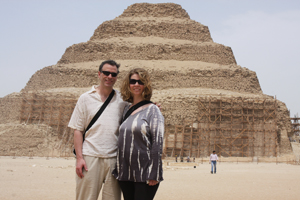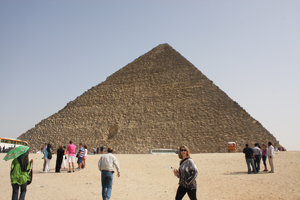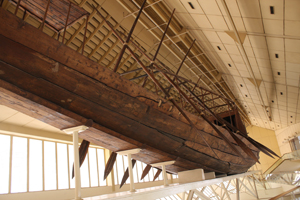Saqqara and Giza
For our second full day in Cairo, we are having our guide from the museum (Mohamed) take us to the pyramids at Saqqara and at Giza. We had originally just planned to see Giza, but when he told us about the full day guided tour that he would take us on, including transportation in his car, it was hard to pass up.
Since we are leaving on the night train, we also had to check out of the hotel, so combined with some time to talk to Nick (the other kids were already asleep), we are up fairly early. Mohamed arrived promptly at 9am, and after convincing hotel security he was legit (even though we weren’t that concerned, it was comforting to see the hotel take enough interest to check all of his credentials and note the information), we headed off to Saqqara.
 Saqqara is most well known as the place, where the first pyramid was built for the pharaoh Djoser, by his architect Imothep (who despite some bad PR in The Mummy, was pretty famous in his own right). This pyramid is known as the Step Pyramid, as it was built as a series of small square platforms on top of one another rather than the straight-sided versions that came later. The pyramid itself was part of a large complex of buildings, such as temples the pharaoh would use in his afterlife, and tombs for the nobility of the time, who were allowed to be buried near the pharaoh. A handful of later pharaohs also built their pyramids at Saqqara, although at a time when Egypt was waning in wealth and power, so none of them were equal in size to the Step Pyramid and attract little attention.
Saqqara is most well known as the place, where the first pyramid was built for the pharaoh Djoser, by his architect Imothep (who despite some bad PR in The Mummy, was pretty famous in his own right). This pyramid is known as the Step Pyramid, as it was built as a series of small square platforms on top of one another rather than the straight-sided versions that came later. The pyramid itself was part of a large complex of buildings, such as temples the pharaoh would use in his afterlife, and tombs for the nobility of the time, who were allowed to be buried near the pharaoh. A handful of later pharaohs also built their pyramids at Saqqara, although at a time when Egypt was waning in wealth and power, so none of them were equal in size to the Step Pyramid and attract little attention.
From Saqqara, we can also see two more of the famous pyramids at Dahshur, about 30km in the distance. These are the Bent Pyramid and the Red Pyramid, both built for the next pharaoh Snefru. Our schedule doesn’t have enough time to see them close up, but we do get a couple of snapshots of them through the haze.
One of the other pyramids at Saqqara was built for the pharaoh Teti, and it is our first opportunity to enter one and walk all the way down into the burial chamber. With the exception of the Great Pyramid (built for Khufu), there is nothing inside of the pyramids, with the actual tomb being built underground. So to enter, you walk duck style down a fairly steep tunnel, where the temperature gets gradually hotter and the air increasingly more stale.
This pyramid was build some 300 years after the Step Pyramid, and one of the new features not present in earlier versions are hieroglyphics carved into the granite walls in every room of the tomb. The detail and volume of these carvings are mind blowing, and we could have easily spent hours in this small room underground just running our fingers over them and trying to imagine them being chiseled into the rock over 4,000 years ago. Ang tried to bribe the guard to let us take a picture (which in retrospect probably wasn’t the best idea), but without success, so there are none to post. Nonetheless, the time spent in this tiny underground room is definitely the high point of our trip to Saqqara.
After a nice lunch down in the valley (where plants actually grow), we head back toward Giza. On the way back, our guide tells us that Saqqara is now well known as a place where carpets are made, and all along the road there are buildings marked as carpet schools. We didn’t stop to take any pictures, but as far as we can tell, “carpet school” loosely translates to Egyptian sweatshop, and is apparently a place where children go to learn how to weave carpets. The front of these buildings are decked out quite nicely and contain the showroom, with the actual school either in the basement, or behind the showroom in a plain, unfinished brick building. We think back to how much our kids complain about how boring their school is and wonder if maybe carpet school would keep them busier.
 We arrive at Giza at little after 1pm, and despite seeing the pyramids for two days already from our balcony, nothing could prepare us for seeing them up close. They are simply massive, and as we walk around them listening to our guide talk about the history, I can’t stop staring, trying to imagine how the ancient Eqyptians could have possibly built something of this scale. Mohamed reminds us that the pyramids at Giza were built around 2500 B.C., so that by the time the Chinese were building the Great Wall, the buildings I am staring at had already survived over two thousand years.
We arrive at Giza at little after 1pm, and despite seeing the pyramids for two days already from our balcony, nothing could prepare us for seeing them up close. They are simply massive, and as we walk around them listening to our guide talk about the history, I can’t stop staring, trying to imagine how the ancient Eqyptians could have possibly built something of this scale. Mohamed reminds us that the pyramids at Giza were built around 2500 B.C., so that by the time the Chinese were building the Great Wall, the buildings I am staring at had already survived over two thousand years.
Mohamed also points out some markers on the ground that show where the original edges of the pyramids would have been as almost all of the smooth limestone casing (save for a small chunk at the top of the pyramid of Khafre) and many of the inner blocks (which are what you see now) were removed over the years and used in the construction of other buildings in Cairo. Based on these markings, I figure that as massive as what stands there today is, easily a third to a half again as many stones must have comprised the original buildings in the time of the pharaohs.
 Behind the pyramid of Khufu, there is a separate museum built specifically to house a wooden boat that was excavated from a pit near his tomb. Rebuilt, the boat measures over 140 feet in length and is made of cedar, which remains in excellent condition even 4,500 years later. Designed for the pharaoh to use in the afterlife, the boat was never actually put into water, but instead was constructed, disassembled, and stored in a pit carved into the limestone, and then covered with a series of huge limestone blocks.
Behind the pyramid of Khufu, there is a separate museum built specifically to house a wooden boat that was excavated from a pit near his tomb. Rebuilt, the boat measures over 140 feet in length and is made of cedar, which remains in excellent condition even 4,500 years later. Designed for the pharaoh to use in the afterlife, the boat was never actually put into water, but instead was constructed, disassembled, and stored in a pit carved into the limestone, and then covered with a series of huge limestone blocks.
We bought an additional ticket to go into the pyramid of Khafre, so head over next to do that. Mohamed tells us there isn’t really much to see inside the pyramids as these were built before the time when the builders started carving hieroglyphics into the walls, and it turns out he is pretty much spot on. It is interesting to see, but mostly because of the scale (the passageways and burial chamber are much bigger than the other pyramids we have been in) and to be able to say that we did it.
Our final stop in Giza is a visit to the Sphinx. Having seen countless images of it over the years, it is nice to have a chance to see the real thing, but up close, it seems a lot more worn down than I imagined it. Because of that, or perhaps because it was at the end of a long day filled with really big things, it doesn’t inspire the same feelings of awe (Ang may say different). Its location is closest to the tour bus drop off so it is also the most crowded part of Giza and we get the opportunity to see a number of klassy (with a K) tourists dressed in tank tops and shorts. We’ve read this is a no-no in a Muslim country so joke a bit about them, but on the inside I definitely acknowledge they are likely pretty darn comfortable, while I am really, really, hot.
Finished with our trip, we head back to the hotel to pick up our bags and get ready for our night train to Aswan. We have a few hours to kill, so we take advantage of some final internet access to talk to all the boys before they head off to school and we head into what may be a 5 day void of connectivity.
April 17th, 2010 at 11:14 pm
Too cool! I can just about visualize what you see from my memories of the “old text books”. History doesn’t get a lot better than this. keep us posted.